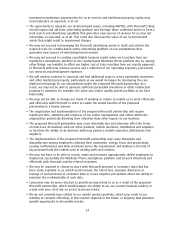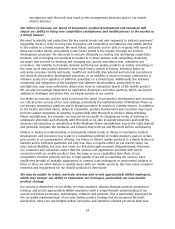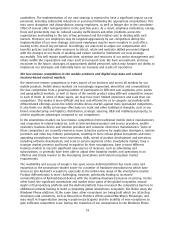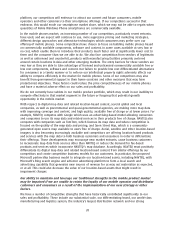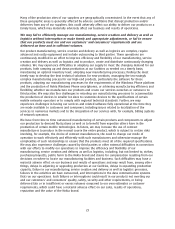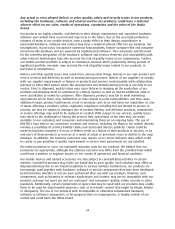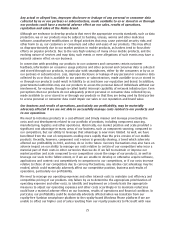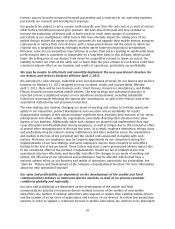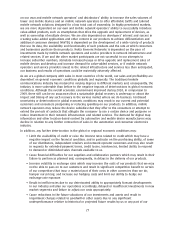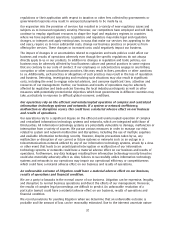Nokia 2010 Annual Report Download - page 24
Download and view the complete annual report
Please find page 24 of the 2010 Nokia annual report below. You can navigate through the pages in the report by either clicking on the pages listed below, or by using the keyword search tool below to find specific information within the annual report.Many of the production sites of our suppliers are geographically concentrated. In the event that any of
these geographic areas is generally affected by adverse conditions that disrupt production and/or
deliveries from any of our suppliers, this could adversely affect our ability to deliver our products on a
timely basis, which may materially adversely affect our business and results of operations.
We may fail to efficiently manage our manufacturing, service creation and delivery as well as
logistics without interruption or make timely and appropriate adjustments, or fail to ensure
that our products meet our and our customers’ and consumers’ requirements and are
delivered on time and in sufficient volumes.
Our product manufacturing, service creation and delivery as well as logistics are complex, require
advanced and costly equipment and include outsourcing to third parties. These operations are
continuously modified in an effort to improve efficiency and flexibility of our manufacturing, service
creation and delivery as well as logistics and to produce, create and distribute continuously changing
volumes. We may experience difficulties in adapting our supply to meet the changing demand for our
products, both ramping up and down production at our facilities as needed on a timely basis;
maintaining an optimal inventory level; adopting new manufacturing processes; finding the most
timely way to develop the best technical solutions for new products; managing the increasingly
complex manufacturing process for our highend products, particularly the software for those
products; adapting our manufacturing processes for the requirements of the Windows Phone platform
and the production of Nokia Windows Phone smartphones; or achieving manufacturing efficiency and
flexibility, whether we manufacture our products and create our services ourselves or outsource to
third parties. We may also face challenges in retooling our manufacturing processes to accommodate
the production of devices in smaller lot sizes to customize devices to the specifications of certain
mobile networks operators or to comply with regional technical standards. Further, we may
experience challenges in having our services and related software fully operational at the time they
are made available to customers and consumers, including issues related to localization of the
services to numerous markets and to the integration of our services with, for example, billing systems
of network operators.
We have from time to time outsourced manufacturing of certain products and components to adjust
our production to demand fluctuations as well as to benefit from expertise others have in the
production of certain mobile technologies. In future, we may increase the use of contract
manufacturers to produce in the normal course the entire product, which is subject to certain risks
involving, for example, the choice of contract manufacturers, the need to change our mode of
operation to work effectively and efficiently with such manufacturers and otherwise manage the
complexities of such relationships to ensure that the products meet all of the required specifications.
We may also experience challenges caused by third parties or other external difficulties in connection
with our efforts to modify our operations to improve the efficiency and flexibility of our
manufacturing, service creation and delivery as well as logistics, including, but not limited to, strikes,
purchasing boycotts, public harm to the Nokia brand and claims for compensation resulting from our
decisions on where to locate our manufacturing facilities and business. Such difficulties may have a
material adverse effect on our business and results of operations and may result from, among other
things, delays in adjusting or upgrading production at our facilities, delays in expanding production
capacity, failure in our manufacturing, service creation and delivery as well as logistics processes,
failures in the activities we have outsourced, and interruptions in the data communication systems
that run our operations. Such failures or interruptions could result in our products not meeting our
and our customers’ and consumers’ quality, safety, security and other requirements, or being
delivered late or in insufficient or excess volumes compared to our own estimates or customer
requirements, which could have a material adverse effect on our sales, results of operations,
reputation and the value of the Nokia brand.
23



